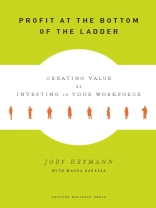Most managers assume that surviving, especially in recessions, requires slashing wages, benefits, and other workforce expenses. And lowest-skilled workers are often viewed as the most expendable.
In Profit at the Bottom of the Ladder, Jody Heymann overturns these assumptions. Drawing from thousands of interviews with employees from front line to C-suite at companies around the world, Heymann shows how enterprises have profited more by improving working conditions.
She also demonstrates that lower-skilled employees – in call centers, repair services, product assembly – aren’t expendable. They can determine 90 percent of companies’ profitability. High performers positively shape customers’ perceptions of businesses, driving satisfaction and loyalty.
To attract, train, and retain top-caliber people in these roles, you must enhance working conditions, creating a system in which your company and its employees profit together. Profit at the Bottom of the Ladder shows what works – from stock options for bakers to flexibility for factory workers to career tracks in call centers.
Featuring cases from companies around the globe – including a leading concrete manufacturer in India, a top European pharmaceutical firm operating in China, and successful U.S. manufacturers – this book shows how real organizations are excelling financially by strengthening frontline employees’ working conditions.
Circa l’autore
Jody Heymann is Founding Director of the Mc Gill Institute for Health and Social Policy. She was Founding Director of the Project on Global Working Families and chair of the Initiative on Work, Family, and Democracy at Harvard University. She has conducted research in thirty-five countries; examined working conditions in 189 nations; and advised leaders in government, UN agencies, and the private sector.












